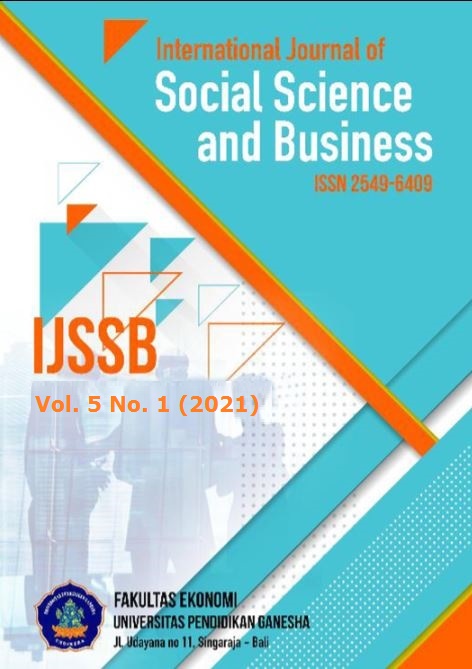Tedung Bali Craft Business Development: SWOT Analysis and Marketing Strategy
DOI:
https://doi.org/10.23887/ijssb.v5i1.28570Keywords:
SWOT analysis, marketing strategy, tedungAbstract
The local potential of the cultural heritage must be able to improve the village economy and the welfare of micro business craftsmen. Tedung is one of the medium of Hinduism ceremony. There is quite a tight competition in Tedung marketing. Marketing is difficult because people don't buy Tedung every day. The types of Tedung handicraft products produced by craftsmen in Mengwi village are still limited with several designs, even though according to their needs and functions. Strategic planning for business development needs to be made so that the operations of Tedung craftsmen can run effectively and efficiently. This study aims to formulate a business development strategy and make Tedung, the handicraft business of the Tedung as an economic booster for the community. This study uses descriptive qualitative research methods with SWOT analysis. This method is able to analyze strengths, weaknesses, opportunities and threats. The data were obtained from interviews with business owners and consumers. The research stages consisted of literature studies, field studies, problem formulation, conducting data analysis using SWOT, formulating marketing strategies for business development for Tedung craftsmen. The target output is that the craftsmen have the knowledge to develop business with increasing efficiency, productivity, scale of production and business competitiveness to get a better welfare.
References
Alma, B. (2016). Manajemen Pemasaran dan Pemasaran Jasa. CV Alfabeta.
Badung, D. M. K. (2018). Industri Kerajinan Tedung/Payung Bali Sebagai Potensi Desa Mengwi.
David, F. . (2009). Manajemen Strategi. Salemba Empat.
Desiyanti, R. (2016). Analisis Swot dan Strategi Pengembangan Pada Keberhasilan Industri Kecil Rotan Kota Padang. Jurnal Apresiasi Ekonomi, 4(1), 1-14. https://doi.org/10.31846/jae.v4i1.142.
Finoti, L., Didonet, S. R., Toaldo, A. M., & Martins, T. S. (2017). The role of the marketing strategy process in the innovativeness-performance relationship of SMEs. Marketing Intelligence and Planning, 35(3), 298–315. https://doi.org/10.1108/MIP-01-2016-0005.
Hadi, S., Wasahua, O., & Masri, Z. A. (2017). Metode Analisis SWOT dalam Pelaksanaan One Village One Product Agribisnis Holtikultura (Studi Kasus di Koperasi Mitra Tani Parahyangan Cianjur). JABE (Journal of Applied Business and Economic), 4(2), 159. https://doi.org/10.30998/jabe.v4i2.2143.
Hidayet, K. İ. (2010). The Importance of Small and Medium-Sized Enterprises (SMEs) in Economies: SWOT Analysis of The SME Sector in Turkey and Albania. Niğde Üniversitesi İktisadi ve İdari Bilimler Fakültesi Dergisi, 3(1), 116–132. https://dergipark.org.tr/en/pub/niguiibfd/issue/19746/211352.
Kotler, P., & Keller, K. L. (2016). Marketing Management :15th Edition. Pearson.
Kurniawan, M., & Haryati, N. (2017). Analysis of Business Development Strategy of Soursop Juice Beverage. Industria: Jurnal Teknologi Dan Manajemen Agroindustri, 6(2), 97–102. https://doi.org/10.21776/ub.industria.2017.006.02.6.
Kusumawijaya, I. K. (2017). PKM Perajin Tedung Desa Mengwi Di Kabupaten Badung, Bali. Proceeding TEAM, 2, 897. https://doi.org/10.23887/team.vol2.2017.224.
Moleong, L. J. (2013). Metodologi Penelitian Kualitatif Edisi Revisi (P. R. Rosdakarya (ed.)).
Mondal, S. H. (2017). SWOT Analysis and Strategies To Develop Sustainable Tourism in Bangladesh. UTMS Journal of Economics, 8(2), 159–167. https://www.econstor.eu/handle/10419/195304.
Nourlette, R. R., & Hati, S. W. (2017). Penentuan Strategi Dengan Pendekatan Analisis Swot Pada Hotel Nongsa Point Marina & Resort Dalam Menghadapi Persaingan Bisnis. Inovbiz: Jurnal Inovasi Bisnis, 5(1), 82. https://doi.org/10.35314/inovbiz.v5i1.174.
Pantiyasa, I. W., & Rosalina, P. D. (2020). The Development Strategy of Paksebali Village Into Smart Eco-Village Destination as a Tourism Icon in Klungkung District-Bali. 226(Icss), 1469–1477. https://doi.org/10.2991/icss-18.2018.308.
Puriansa, J., & Donni. (2017). Perilaku Konsumen Dalam Persaingan Bisnis Kontemporer CV. Alfabeta
Setiawannie, Y., & Rahmania, T. (2019). Performance measurement of public hospitals through the integration of SWOT and balanced scorecard. Jurnal Sistem Dan Manajemen Industri, 3(2), 76. https://doi.org/10.30656/jsmi.v3i2.1472.
Singarmbun, M., & Effendi, S. (2008). Metode Penelitian Survei (LP3ES (ed.)).
Sudiatmika, A. . I. A., Sadia, I. W., & Supir, I. K. (2017). Komodifikasi tedung upacara menjadi lampu hias. 1,2. Seminar Nasional Pengabdian Kepada Masyarakat, 416–422. https://eproceeding.undiksha.ac.id/index.php/senadimas/article/download/1104/831.
Sudrajat, J., Rahman, M. A., Sianturi, A., & Vendy, V. (2016). Entrepreneurship Learning Process by using SWOT Analysis. The Winners, 17(1), 67. https://doi.org/10.21512/tw.v17i1.1811.
Sukaatmadja, I. P. G., Yasa, N. N. K., Rahyuda, H., & Widagda, I. G. N. J. (2014). Strategi Pengembangan Pasar Tradisional Berbasis Kearifan Lokal untuk Mengentaskan Kemiskinan di Bali. Matrik: Jurnal Manajemen, Strategi Bisnis dan Kewirausahaan, 8(2), 121–129. https://ocs.unud.ac.id/index.php/jmbk/article/view/14365.
Thamrin, H., Herlambang, R., Brylian, B., Gumawang, A. K. A., & Makmum, A. (2017). A SWOT analysis tool for Indonesian small and medium enterprise. ARPN Journal of Engineering and Applied Sciences, 12(2), 620–625. http://www.arpnjournals.org/jeas/research_papers/rp_2017/jeas_0117_5664.pdf.
Zainuri, M., Nuringwahyu, S., & Zunaida, D. (2019). Analisis SWOT Sebagai Dasar Untuk Merencanakan Strategi Pemasaran (Studi Pada Ciptaningati Culture Hotel). JIAGABI (Jurnal Ilmu Administrasi Niaga/Bisnis), 8(1), 40-50. http://www.riset.unisma.ac.id/index.php/jiagabi/article/view/1938.











